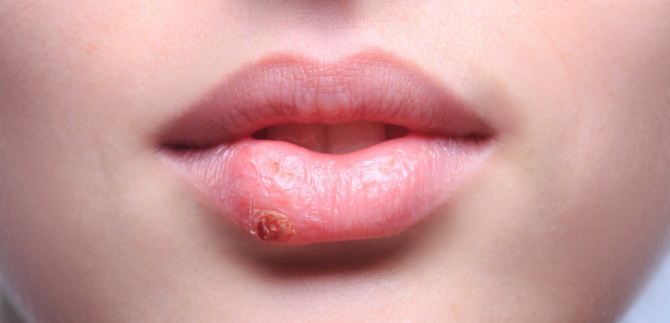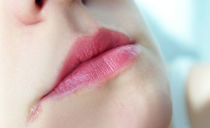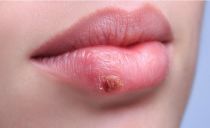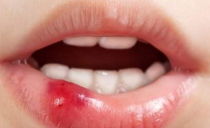Lip diseases in adults and children: names with photos, causes, symptoms and treatment
The lips are very thin skin, so they are practically not protected from external influences. Because of this, every person at least once in his life had to deal with various diseases of the lips. In medicine they have common name - cheilitis. There are about a dozen varieties of this disease.
Content
Reasons why lip diseases develop
Human lips are very vulnerable, which often leads to their redness, irritation, dryness and even the formation of wounds and crusts. Most often, cheilitis develops under the influence of external factors.: low temperature, wind, sunlight. Under their influence, the skin around the mouth dries out, which in itself is unpleasant. If you do nothing with this, the problem will only get worse.
The second factor that causes lip diseases is various allergens. The culprit of the pathological reaction can be both food and cosmetics. Malfunctions in the functioning of the internal systems of the body can also affect the face.
Most often, the delicate skin around the mouth suffers due to disturbances in the hormonal background, fungal and viral lesions. Vitamin deficiency, indigestion and a general deterioration in immunity can exacerbate the situation.
There are less common causes of lip diseases. Usually they lead to certain types of cheilitis.
Types of lip diseases
Cheilitis can be divided into several categories. Here are their names:
- exfoliative;
- glandular;
- meteorological;
- actinic;
- atopic;
- eczematous;
- candidiasis.
In addition, there are other diseases that are not related to cheilitis. Therefore, dryness, peeling, crusting, a red border near the lips are reasons for serious concern and a reason for examining the entire body.
Atopic cheilitis
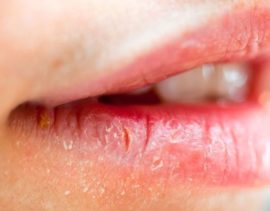 Atopic cheilitis is sometimes called allergic, because it causes various irritants. The cause of the development of the disease may be food or cosmetics. It turns out that the allergen acts on the skin of the lips both from the inside and outside.
Atopic cheilitis is sometimes called allergic, because it causes various irritants. The cause of the development of the disease may be food or cosmetics. It turns out that the allergen acts on the skin of the lips both from the inside and outside.
The disease manifests itself in the form of inflammation of the red border of the lips. The skin becomes dry, peeling. Cracks, itching, and burning are possible.
Most often, allergies on the lips affect children and adolescents. Often, it is the only symptom of neurodermatitis or atopic dermatitis.
Glandular cheilitis
Glandular cheilitis is an inflammation of the salivary glands that are located near the surface of the mucous membrane of the lips. The disease is more common in men older than 50 years and is characterized by the following symptoms:
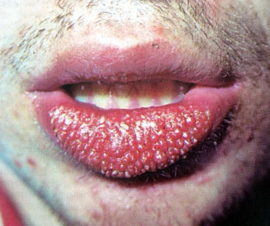 noticeable red dots appear on the lower lip;
noticeable red dots appear on the lower lip;- copious saliva from inflamed glands, the appearance of "dewdrops";
- dryness, cracks and erosion;
- bacteria can lead to pus formation in irritated canals.
Distinguish between the primary and secondary form of glandular cheilitis. The primary ailment develops due to a genetic predisposition. Lupus, oral leukoplakia, or lichen planus may cause secondary lip disease.
Meteorological cheilitis
People have to deal with this ailment constantly.Standard weathering, which often manifests itself in winter, is meteorological cheilitis.
The first sign of the disease is a feeling of tightness of the skin. In advanced cases, it turns red, withers, becomes covered with cracks. You can treat such lip inflammation at home. It is enough to fence yourself off from harmful factors, moisturize and nourish the skin until complete recovery.
Eczematous cheilitis
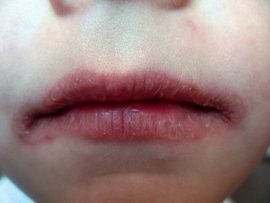 Eczematous cheilitis is one of the manifestations of eczema - an inflammatory process of a neuroallergic nature, which often manifests itself on the face or dry parts of the body. Usually the disease is accompanied by constant dryness and redness. In advanced cases, the skin begins to peel off and becomes covered with blisters.
Eczematous cheilitis is one of the manifestations of eczema - an inflammatory process of a neuroallergic nature, which often manifests itself on the face or dry parts of the body. Usually the disease is accompanied by constant dryness and redness. In advanced cases, the skin begins to peel off and becomes covered with blisters.
The disease often affects the tissues around the lips, so the patient may form a red border, as in the photo on the right. This area of skin is constantly itchy and itchy.
If the disease is chronic, the symptoms are less pronounced. But in this case, seals appear on the skin.
Actinic cheilitis
Many believe that lips should be protected only in winter. Therefore, it is at this time of the year that people stock up on moisturizing and nourishing balms to reduce dryness and itching of the lips. However, delicate skin must be protected not only from frost, but also from the burning sun.
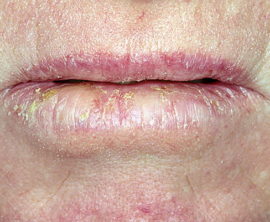 With increased sensitivity to ultraviolet light and prolonged exposure to open areas, actinic cheilitis is formed. Symptoms are standard:
With increased sensitivity to ultraviolet light and prolonged exposure to open areas, actinic cheilitis is formed. Symptoms are standard:
- dryness, peeling;
- redness and swelling;
- compaction of individual sections.
If nothing is done, the lips are covered with a crust. So the body is trying to somehow protect the vulnerable part of the face. This symptom is less common than others.
In advanced cases, ulcers, erosions, and small seals appear around the oral cavity. This condition is precancerous.
Exfoliative cheilitis
The exfoliative form of the disease occurs due to stress and impaired immune function. A large role is played by genetic predisposition. If your parents had such a disease, the risk is high that it will occur in you.
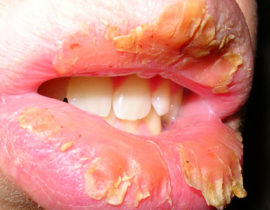 Exfoliative cheilitis on the lips occurs in two forms: exudative and dry. In the first case, one can observe the so-called yellow lips (pictured). A dense crust of this shade forms on the skin.
Exfoliative cheilitis on the lips occurs in two forms: exudative and dry. In the first case, one can observe the so-called yellow lips (pictured). A dense crust of this shade forms on the skin.
The yellow peel is easy to tear off, this process does not cause much discomfort. There is no erosion or other damage under the crust.
With the dry form of the disease, a crust on the lips also forms, but not yellow, but a lighter shade. The patient is concerned about the dryness of the skin, which explains the name of the disease. There is a desire to lick your teeth, but it’s better not to do this: you can introduce an infection and provoke more irritation.
Candidiasis cheilitis
If the lips are reddened, inflamed and crusty with a cheesy coating of white or yellowish color, then candidiasis became the cause of this symptomatology. If you remove the plaque, inflamed skin areas will be exposed. How a similar lip disease manifests itself is shown in the photo.
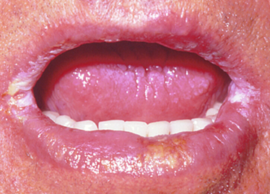 The disease occurs due to the overdevelopment of Candida. The causative agent lives on the human mucous membranes constantly, but the active development of the fungus begins only under favorable conditions, which include:
The disease occurs due to the overdevelopment of Candida. The causative agent lives on the human mucous membranes constantly, but the active development of the fungus begins only under favorable conditions, which include:
- decreased immunity due to past illnesses or lack of nutrients;
- long-term use of antibiotics;
- a sharp change in climate to hotter and wetter.
Fungal inflammation of the lips begins outside, but can also spread to the internal tissues of the oral cavity, thus leading to candidal stomatitis.
Lip cancer
Many of these diseases, if not given proper attention to their treatment, lead to cancer. Perhaps this is the worst disease that can affect the lips and mouth.
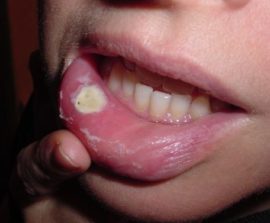 At first, the symptoms of cancer are unremarkable. The lips turn red, a slight inflammation appears. The skin may dry out and become cracked.If the patient moisturizes and nourishes the affected tissue, but the lips remain inflamed for several weeks, he should be alarmed and consult a specialist. Ulcers and seals may appear later.
At first, the symptoms of cancer are unremarkable. The lips turn red, a slight inflammation appears. The skin may dry out and become cracked.If the patient moisturizes and nourishes the affected tissue, but the lips remain inflamed for several weeks, he should be alarmed and consult a specialist. Ulcers and seals may appear later.
Usually, if the treatment is started correctly and on time, the cancer recedes completely. Only in rare cases, relapses are possible.
There is another disease that is compared to cancer - Manganotti syndrome. The disease manifests itself in the form of a noticeable ulcer on the lip, which is a precancer. However, due to the fact that in most cases the syndrome still develops into a tumor, it is more often referred to as cancer.
Features of the course of cheilitis in children
Lips suffer due to minimal protection. In babies, it is even weaker, so cheilitis worries them more often. In addition to children, the risk group includes older people and pregnant women.
The main causes of cheilitis in childhood:
- an allergic reaction to food;
- the use of skin care products for the lips and around them, not intended for children;
- genetic predisposition;
- infectious and fungal infections;
- weather.
Usually, child cheilitis does not develop to critical stages. When children have red lips, parents immediately begin to treat them. After all, people are more attentive to the health of the younger generation than to their own. If cheilitis in children still requires treatment, therapy does not drag out longer than a few weeks. The main thing is to remove all allergens from the children's diet and balance nutrition.
How to treat lips with cheilitis
The most important thing in the treatment of cheilitis is to identify its cause, which is difficult to do without professional help. Have to contact a specialist. First, it’s better to go to the therapist, and already he will refer you to a narrow-profile doctor.
Usually the treatment of diseases of the lips and skin around the mouth is based on eliminating not the symptoms, but the root causes. It includes lifestyle changes, proper nutrition, and medication.
If the cause of the inflammation is an infectious or fungal infection, topical preparations are included in the therapy. Typically, patients are prescribed various therapeutic ointments for external use, which must be applied to damaged skin several times a day:
- anti-inflammatory - Tetracycline, Erythromycin;
- antifungal - clotrimazole;
- hormonal - prednisone.
To cure lips, you need to work on them not only from the outside, but also from the inside. The skin around the mouth often suffers from a lack of B vitamins, so they are often prescribed for lip treatment.
How to get rid of unpleasant symptoms at home
It is not worthwhile to be treated at home without going to the doctor. However, there are ways that you can resort to to reduce discomfort:
- If the lips become inflamed due to the sun or cold, it is advisable that they are always covered with a protective layer of balm.
- With severe itching and burning, manifested in almost all forms of cheilitis, cold compresses will help. Before applying them, the skin is covered with a layer of balm, so that, along with a decrease in pain, lip treatment also occurs.
- If the lips are red and covered with cracks, sores or any other open wounds, care must be taken to prevent bacteria from entering them. It is necessary to treat the surrounding skin and teeth with a cotton pad dipped in hydrogen peroxide or in Miramistin. The best effect will have special antiseptic ointments.
- If pain and itching are intolerable, pain medication can be used. The ointments with a cooling effect will have the same effect.
All methods of alternative treatment of cheilitis will be useless if you resort to them thoughtlessly - without consulting a doctor. In most cases, inflammation, redness, and itching of the lips are harmless. Such symptoms can go away even without therapy, but sometimes they indicate dangerous diseases, so you can not neglect medical help.

